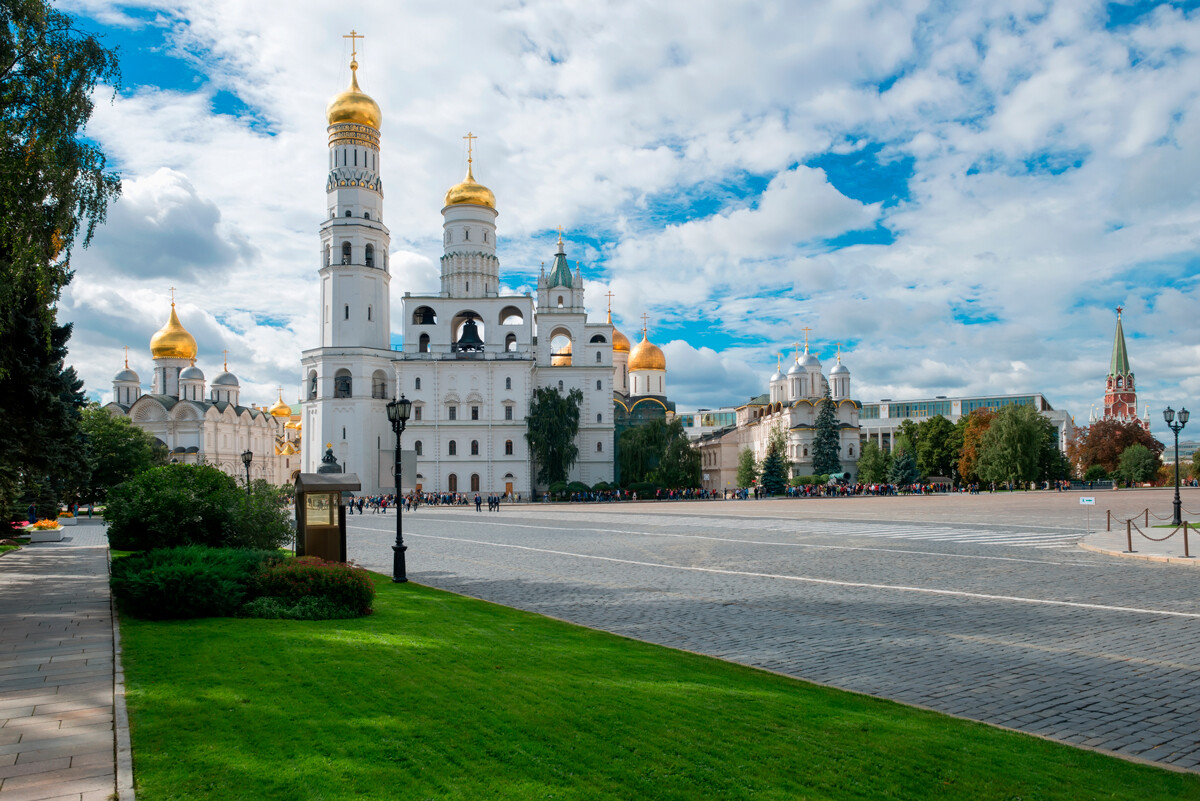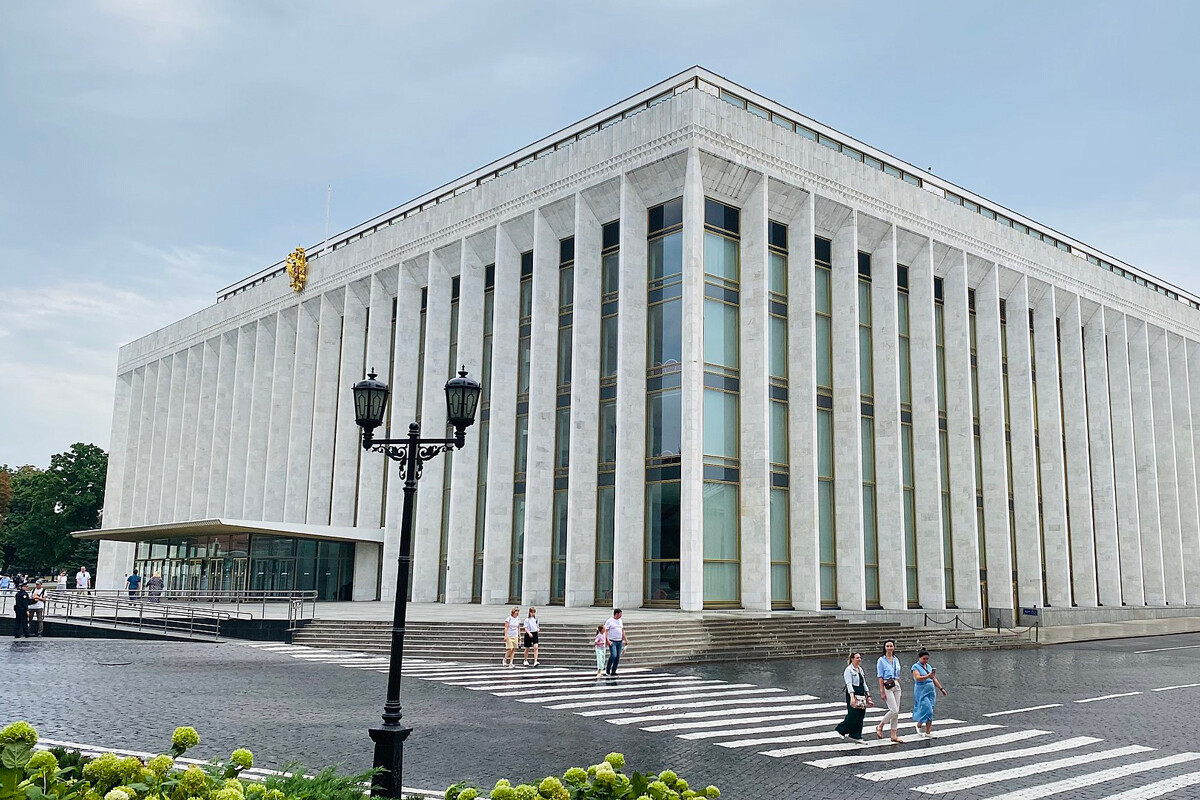10 places inside the Moscow Kremlin you shouldn’t miss (PHOTOS)

1. Ivanovskaya Square
In the 16th-17th centuries, this place was the center of business in Moscow. In 1329, a square was paved around the Church of St. Ivan of the Ladder: its eastern part was called Ivanovskaya, while its western part – Cathedral Square.

On Ivanovskaya Square, town criers announced the most important news and, later, it grew into a saying that still survives to our day: “To shout through the whole Ivanovskaya”, which means to speak very loudly and emotionally. In 1505, the church was torn down; to the east of it, Italian architect Bon Fryazin built the Ivan the Great Bell Tower.
Located across the entrance to the Kremlin territory from the Spasskaya Tower side.
2. Tsar Cannon & Tsar Bell

The Tsar Cannon is the largest cannon in the world, with a caliber of 890 mm. And, although it was created as a real weapon, it was never used in battle (or, according to some sources, just once). It was cast in 1586 and stood right on the Red Square near the Spassky Gate. Later, the 40-ton cannon was put on a pedestal inside of the Kremlin, with decorative cannonballs cast to finish the composition.
The Tsar Bell appeared in the 18th century during the rule of Anna Ioannovna. With a height of 6.14 meters and a weight of almost 202 tons, it is the largest bell in the world. They didn’t manage to use it as intended, because the bell, which was in a pit, heated up during a fire in the Kremlin and cracked after it was doused with water. A piece weighing 11.5 tons split from it and now it sits next to the main part of the bell on the territory of the Kremlin.
Located near Ivanovskaya Square and the Ivan the Great Bell Tower.
3. Dormition Cathedral

This cathedral is one of the oldest buildings on the territory of the Kremlin – it was built in 1475-1479 by invited Italian architect Aristotele Fioravanti on the order of Grand Prince of Moscow Ivan III. From the time of Peter the Great’s rule, it held Russian imperial coronations. Until 1917, it was the main cathedral of Russia; now it’s a functioning church.
Also, the oldest religious frescoes of Moscow are inside of this cathedral – dating back to the 15th century.
Located on Cathedral Square between the Palace of Facets and the Church of the Twelve Apostles.
4. Palace of Facets

This building was erected in 1487-1491 by Italians Marco Fryazin and Pietro Antonio Solari and, for several centuries, right until the rule of Peter the Great, it hosted the tsar’s main halls of Russia. For example, tsars received foreign envoys there, made important decisions and arranged receptions. The palace was called the ‘Palace of Facets’ for the distinct cladding of its main facade: the wall was decorated with “diamond rustication” – tetrahedral blocks from cut white stone.
Located on Cathedral Square between the Dormition Cathedral and the Cathedral of the Annunciation.
5. Taynitsky Garden & Grand Kremlin Public Garden

A large parkland sprawls near the southern wall of the Kremlin – presumably it has existed there since the 14th century. The name of the garden was changed many times; until in the 19th century, it was renamed Taynitsky Garden in honor of one of the Kremlin towers near the park. The ‘Cosmos’ oak tree is among the most interesting plants there – it was personally planted by the first astronaut in history, Yuri Gagarin.
Located under the southern wall of the Kremlin, near the Cathedral of the Archangel and the Taynitskaya Tower.
6. Grand Kremlin Palace

This palace, built in the 19th century, was once an imperial residence. It was erected by the order of Nicholas I. In Soviet times, it was the seat of the government.
This two-story house in the unique Byzantine-Russian style possesses a truly colossal area – about 25,000 sq. meters. Today, the majority of the rooms are off-limits for visitors – they are a part of the residence of the President of Russia; however, excursions are still conducted to a minor part of the halls.
Located near the southern wall of the Kremlin behind the Cathedral of the Annunciation and across the Amusement Palace.
7. Amusement Palace

This building with golden domes and a terem-like upper story was built in 1651 for boyar Miloslavsky, the father-in-law of Tsar Alexei Mikhailovich. Later, the building was renamed the Amusement Palace – it hosted the first theatrical performances in Russian history. Back then, such a performance was called ‘potekha’ (‘amusement’), hence the name (‘Poteshny Palace’).
Located across the Grand Kremlin Palace near the western wall of the Kremlin.
8. Kremlin Armory

This neoclassical building was erected in 1844-1851 as a museum house – to preserve and exhibit the treasures of the tsar’s treasury. Today, you can find Russian and foreign jewelry of the 12th-19th centuries there, as well as weapons and armor, state regalia, carriages, costumes and much more. The ground floor hosts the ‘Diamond Fund’, which exhibits precious nuggets and tsars’ jewelry.
Located near the Amusement Palace.
9. State Kremlin Palace (Palace of Congresses)

This is one of the buildings of the Soviet period that is located on the territory of the Kremlin. It was built in 1961 on the initiative of the then head of the USSR Nikita Khrushchev – he wished for Party Congresses to be held in a giant hall with a capacity of 6,000 people. Currently, the State Kremlin Palace is considered the main theatrical and concert platform of Russia – the most famous Russian and foreign performers and theater groups perform there; the main New Year celebration of the country is also held there.
Located between Senate Square and Trinity Square near the western wall of the Kremlin.
10. Kremlin Arsenal (Zeughaus)

At the beginning of the 18th century, on the initiative of Peter the Great, one of the most large-scale buildings of the time was erected on the territory of the Kremlin. Back then, the emperor planned to arrange a military warehouse, a museum of military glory and trophy storage inside – he even personally worked on the plans, according to which the Arsenal was built. Napoleon blew it up in 1812 when retreating from Moscow; however, later, the building was restored. Today, it hosts the barracks of the Kremlin Regiment and the Kremlin commandant’s office administration.
Located on Trinity Square in the northern part of the Kremlin.

